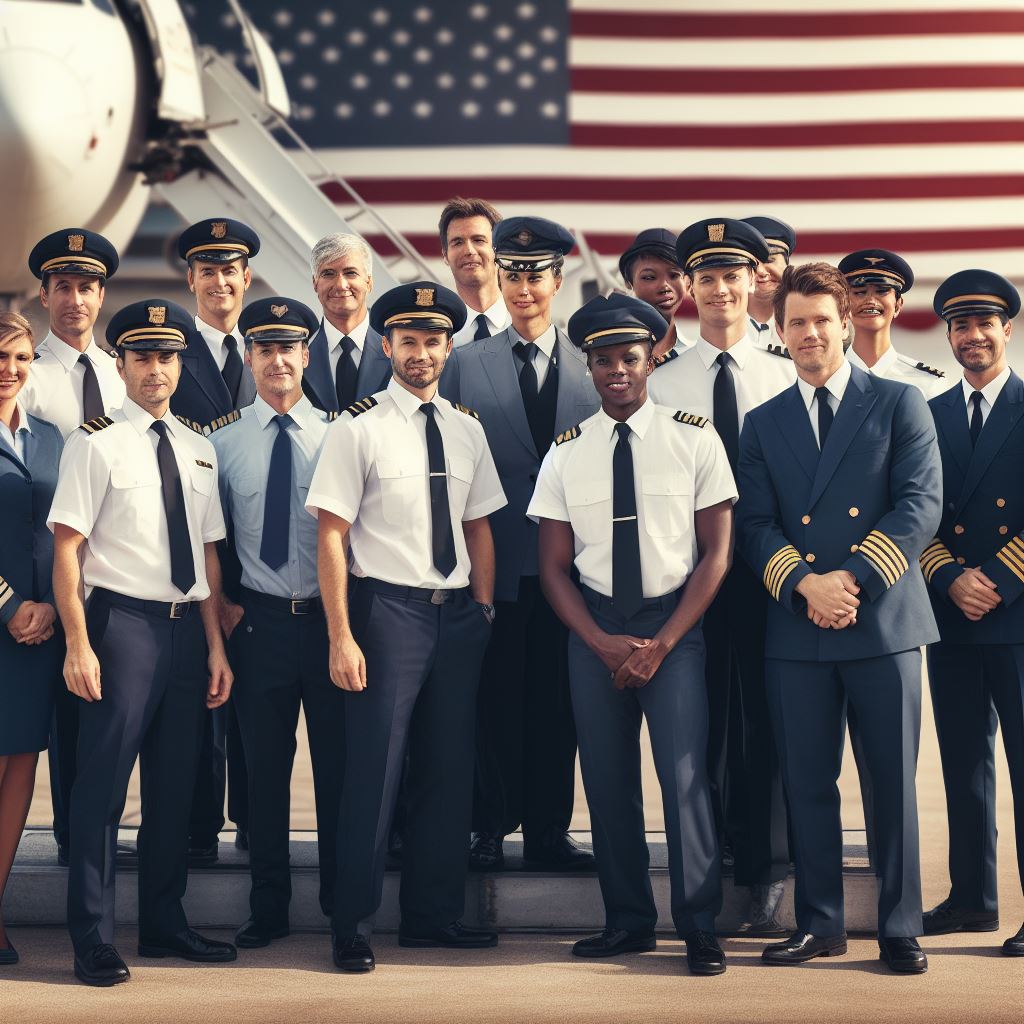Introduction
Understanding common flight routes is essential for US-based commercial pilots. It allows them to navigate efficiently and ensures smooth operations.
This blog section provides an overview of why this knowledge is crucial and outlines the purpose of the post.
Importance of understanding common flight routes
Knowing common flight routes helps pilots optimize their flight plans, saving time and fuel.
It also enhances safety by familiarizing them with the route’s specific challenges and potential obstacles. Understanding these routes is key to successful navigation.
Overview of US-based commercial pilots
US-based commercial pilots operate a wide range of flights, from domestic to international routes.
They transport passengers and cargo, ensuring efficient and reliable air travel.
These pilots undergo rigorous training and hold the necessary certifications to ensure the utmost safety in their operations.
Purpose of the blog post
The purpose of this blog post is to provide commercial pilots with valuable insights into the common flight routes in the United States.
By understanding these routes, pilots can improve their decision-making processes and optimize their flight operations, ultimately benefitting both passengers and airlines.
Basically, the importance of understanding common flight routes cannot be overstated for US-based commercial pilots.
This knowledge enables them to navigate efficiently, enhance safety, and optimize their operations.
The subsequent sections will delve deeper into the specific flight routes commonly used by US commercial pilots.
North American Flight Routes
East Coast to West Coast
Flying from the East Coast to the West Coast is one of the most common flight routes for US-based commercial pilots.
This transcontinental journey connects major cities, bustling airports, and popular airlines. Let’s explore the different aspects of these flight routes.
East Coast to West Coast flights involve major airports such as John F. Kennedy International Airport (JFK) in New York, Los Angeles International Airport (LAX) in California, and San Francisco International Airport (SFO).
These airports play a significant role in accommodating the high volume of travelers flying between these coasts.
Several well-known airlines operate these routes, including Delta Air Lines, American Airlines, and United Airlines.
They provide frequent flights to meet the demand of travelers moving between the East Coast and the West Coast.
Northeast to Florida
Another popular route is from the Northeast to Florida. Travelers from cities like Newark, New Jersey, and Boston, Massachusetts, frequently fly to Miami and Orlando, two popular destinations in Florida.
These routes witness seasonal variations, with increased demand during the winter months when people escape the cold Northeast for warmer Florida.
Transform Your Career Today
Unlock a personalized career strategy that drives real results. Get tailored advice and a roadmap designed just for you.
Start NowTranscontinental routes
Transcontinental routes connect key cities across the country. Flights from major metropolitan areas like New York City, Boston, and Chicago to Los Angeles and San Francisco are common.
These routes link important business hubs and attract travelers for various purposes.
However, long-haul flights pose unique challenges for pilots.
The duration of these flights can be between 4 to 6 hours depending on wind conditions.
Pilots must remain vigilant and focused during extended flying time, managing potential fatigue due to time zone changes and limited rest opportunities.
Weather conditions can also pose challenges during these flights, especially when crossing different regions of the country.
Pilots must navigate through potential turbulence and adverse weather conditions to ensure a smooth and safe journey for passengers.
In fact, the flight routes from the East Coast to the West Coast, Northeast to Florida, and various transcontinental paths play a crucial role in connecting travellers across North America.
Pilots encounter different airports, airline operations, and challenges while flying these routes regularly.
It is their expertise and dedication that ensure passengers reach their destinations safely and efficiently.
Read: Earning Potential: Salaries of US-based Pilots
International Flight Routes
Europe
Europe is a top international destination for US-based commercial pilots due to its rich history, diverse cultures, and vibrant cities.
There are numerous popular flight routes from the US to various European destinations. Some of the most sought-after destinations include:
- London, England: Known for its iconic landmarks like Big Ben, Buckingham Palace, and the Tower of London.
- Paris, France: Famous for its romantic ambiance, the Eiffel Tower, Louvre Museum, and exquisite cuisine.
- Rome, Italy: Home to ancient ruins like the Colosseum and historic sites such as the Vatican City.
- Amsterdam, Netherlands: Renowned for its picturesque canals, tulip fields, and vibrant nightlife.
- Barcelona, Spain: Offers stunning architecture, beautiful beaches, and a thriving culinary scene.
These are just a few examples of the many popular destinations in Europe that attract US-based commercial pilots.
When it comes to airlines serving these routes, there are several major carriers that connect the US with Europe.
These airlines provide numerous flights and schedule options for pilots and passengers.
Some of the prominent airlines serving the European routes include:
- Delta Air Lines: Known for its extensive network and excellent service, Delta operates flights to various European cities.
- American Airlines: Another major carrier offering multiple routes to Europe, providing convenient options for commercial pilots.
- United Airlines: With its global reach, United offers numerous flights connecting the US with major European destinations.
- British Airways: As the flag carrier of the United Kingdom, British Airways provides flights to and from the US and several European cities.
- Lufthansa: Germany’s largest airline, Lufthansa, offers extensive connections between the US and European hubs.
These airlines provide essential transportation for US-based commercial pilots and contribute to the high demand for international flights to Europe.
Asia
Asia is another significant region with increasing travel demands, and there are several major flight hubs that serve as important destinations for US-based commercial pilots.
Some of the major hubs in Asia include:
Transform Your Career Today
Unlock a personalized career strategy that drives real results. Get tailored advice and a roadmap designed just for you.
Start Now- Tokyo, Japan: A bustling metropolis known for its cutting-edge technology, traditional temples, and unique culinary experiences.
- Singapore: The Lion City offers a blend of modernity and cultural heritage, along with a thriving business hub.
- Dubai, United Arab Emirates: Known for its awe-inspiring architecture, luxury shopping, and a rapidly growing aviation industry.
- Hong Kong: An international financial center known for its impressive skyline, bustling markets, and vibrant nightlife.
- Seoul, South Korea: A dynamic city embracing both tradition and innovation, featuring ancient palaces and modern skyscrapers.
These major hubs not only attract leisure travelers but also serve as crucial business and trade centers, driving the need for direct flights from the US.
Moreover, Asia’s expanding markets and emerging routes make it an exciting destination for US-based commercial pilots.
As economic growth continues in countries like China and India, more airlines are establishing connections between the US and various cities in Asia.
This expansion of flight routes creates more opportunities for pilots to explore this diverse region.
Latin America and the Caribbean
Latin America and the Caribbean are popular destinations for US-based commercial pilots due to their beautiful beaches, vibrant culture, and warm climates.
Key flight connections between the US and this region include:
- Cancun, Mexico: A popular vacation spot known for its stunning beaches, ancient Mayan ruins, and vibrant nightlife.
- Rio de Janeiro, Brazil: Home to iconic attractions like Christ the Redeemer, Copacabana Beach, and the Carnival festival.
- Puerto Rico: A Caribbean Island with a rich history, pristine beaches, and a unique blend of Spanish and American influences.
- Costa Rica: Famous for its biodiversity, lush rainforests, and adventure tourism opportunities like zip-lining and surfing.
- Machu Picchu, Peru: The ancient Incan city nestled in the Andes Mountains, attracting history enthusiasts and trekkers.
In recent years, there has been a significant increase in travel to Latin America and the Caribbean.
Travel trends in this region include eco-tourism, luxury resorts, cultural exploration, and culinary experiences.
US-based commercial pilots play a crucial role in facilitating travel to these destinations and meeting the growing demand.
Overall, international flight routes offer US-based commercial pilots a myriad of exciting destinations to explore, both in Europe and in other regions like Asia, Latin America, and the Caribbean.
These routes connect the world and provide opportunities for pilots to experience diverse cultures and expand their professional horizons.
Read: Military vs. Civilian Pilot Careers: Pros and Cons

Regional Flight Routes
Connecting smaller cities within the US
Importance of regional airlines – Regional airlines play a crucial role in connecting smaller cities and towns within the United States.
They provide vital transportation options for residents, tourists, and businesses in these areas.
Common routes for regional pilots – Regional pilots often operate on shorter distance routes between smaller airports, connecting regional hubs with major airport hubs.
These routes cater to the specific needs of local communities and businesses.
Routes within specific states or regions
Examples of popular flight connections – Within certain states or regions, there are specific flight routes that are highly popular among both business and leisure travelers.
For example, flights between New York and Washington D.C., or between Los Angeles and San Francisco.
Impact on local economies and tourism – These flight connections have a significant impact on local economies and tourism industries.
They facilitate travel and encourage business activities, which in turn stimulate economic growth and generate revenue for local businesses.
Transform Your Career Today
Unlock a personalized career strategy that drives real results. Get tailored advice and a roadmap designed just for you.
Start NowRead: The Path to Becoming a Commercial Pilot in the USA
You Might Also Like: Networking for Logisticians: Top U.S. Associations & Events
Factors Influencing Flight Routes
Flight routes for US-based commercial pilots are influenced by various factors that impact route planning, efficiency, and passenger safety.
Weather conditions, air traffic control restrictions, and airport slot availability all play significant roles in determining the routes pilots take.
Weather conditions
When planning flight routes, weather conditions are a primary consideration for pilots.
They have to take into account factors such as wind patterns, storms, and turbulence.
Adverse weather conditions can affect the safety and comfort of passengers, so pilots must carefully assess weather forecasts and make route adjustments accordingly.
1. How it affects route planning
Unfavorable weather conditions can result in route modifications to avoid turbulent areas or severe storms.
Pilots need to analyze weather patterns along the planned route and decide whether to deviate from their original flight path.
This ensures a smoother journey for passengers and reduces the risk of turbulence-related incidents.
2. Strategies to deal with adverse weather patterns
Pilots employ various strategies to handle adverse weather patterns. They collaborate with meteorologists to obtain real-time weather updates and forecasts.
If unfavorable conditions are predicted, pilots can choose alternate flight routes to bypass turbulent areas or wait until the weather improves before taking off.
These proactive measures prioritize passenger safety and ensure a pleasant travel experience.
Air traffic control restrictions
Air traffic control (ATC) imposes restrictions that significantly impact the choice and efficiency of flight routes. ATC manages and regulates the flow of air traffic to maintain safe and orderly skies.
1. Impact on route choice and efficiency
ATC assigns specific routes to aircraft, considering factors such as airspace congestion and traffic flow.
These assigned routes may not always align with the most direct path, causing deviations and affecting both fuel efficiency and flight duration.
Pilots must carefully comply with ATC instructions while also aiming for optimal route efficiency.
2. Collaborative efforts to optimize routes
Pilots and air traffic control work collaboratively to optimize flight routes.
They communicate constantly during flight planning and execution to coordinate airspace usage.
By sharing real-time information on weather conditions, traffic patterns, and airspace availability, pilots and ATC strive to find the most efficient routes that minimize delays and reduce fuel consumption.
Transform Your Career Today
Unlock a personalized career strategy that drives real results. Get tailored advice and a roadmap designed just for you.
Start NowAirport slot availability
Busy airports frequently face congestion and have limited slots available for takeoffs and landings. This slot availability can significantly impact flight route planning for commercial pilots.
1. Limited slots at busy airports
Airports with high passenger traffic and limited runway capacity have restricted slots for arrivals and departures.
This imposes constraints on pilots’ route choices, departure times, and overall scheduling.
Commercial airlines must carefully allocate these slots to ensure efficient use of airport resources and minimize delays.
2. Alternate route options and scheduling adjustments
Pilots must consider alternate route options when faced with slot availability challenges.
They may need to adjust departure times or select alternative airports in the vicinity.
These adjustments help accommodate limited slot availability while ensuring timely and smooth travel for passengers.
Flexibility in route planning becomes essential to overcome any constraints posed by busy airports.
Essentially, flight routes for US-based commercial pilots are influenced by various factors such as weather conditions, air traffic control restrictions, and airport slot availability.
Pilots adopt strategies to deal with adverse weather patterns, collaborate with ATC for optimized routes, and navigate slot availability challenges at busy airports.
These factors shape the flight planning process and contribute to a safe and efficient travel experience for passengers.
Read: Surviving Winter: Tips for Truck Drivers in Snowy Conditions
See Related Content: Essential Tools & Software Every American Logistician Needs
Conclusion
Recap of common flight routes for US-based commercial pilots
US-based commercial pilots frequently fly between major hubs such as New York, Los Angeles, Chicago, and Atlanta, as well as other popular destinations like Miami, Las Vegas, and San Francisco.
These routes are in high demand due to business travel, tourism, and economic activity in these cities.
Importance of staying updated on current trends and changes
It is crucial for commercial pilots to stay informed about current trends and changes in flight routes.
Airlines constantly adjust their schedules to meet passenger demand and market conditions.
By staying updated, pilots can better plan their careers and efficiently navigate the skies.
Encouragement to explore new routes and gain diverse experiences
While sticking to common flight routes offers stability, pilots should also consider exploring new routes.
Flying to different destinations allows pilots to gain diverse experiences and broaden their skillsets.
Transform Your Career Today
Unlock a personalized career strategy that drives real results. Get tailored advice and a roadmap designed just for you.
Start NowThey can learn about different airspace environments, navigate challenging terrains, and handle varying weather conditions.
Exploring new routes also opens up opportunities for pilots to interact with different cultures, cuisines, and lifestyles, providing a rich and rewarding professional and personal journey.
It allows them to grow as aviators and individuals in their chosen profession.
US-based commercial pilots should be aware of the common flight routes that dominate the industry.
However, they should also stay updated on current trends and changes, actively seek new routes, and embrace diverse experiences.
By doing so, pilots can become more versatile and achieve a fulfilling career in aviation.
[E-Books for Sale]
The Big Book of 500 High-Paying Jobs in America: Unlock Your Earning Potential
$19.99 • 500 High-Paying Jobs • 330 pages
Explore 500 high-paying jobs in America and learn how to boost your career, earn more, and achieve success!
See All 500 High-Paying Jobs of this E-Book
1001 Professions Without a Degree: High-Paying American Jobs You Can Start Now
$19.99 • 1001 Professions Without a Degree • 174 pages
Discover 1001 high-paying jobs without a degree! Unlock career tips, skills, and success strategies for just $19.99!




